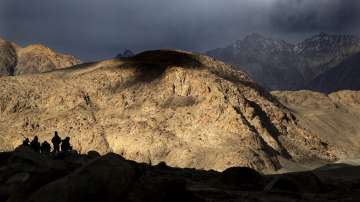India bolsters dominance in over 20 strategic heights overlooking China at friction points near Pangong Lake
Amid tension at the Line of Actual Control (LAC) and when both sides are holding another round of talks, India further bolstered its dominance in over 20 mountain heights around the friction points near the Pangong lake, sources have said.

Amid tension at the Line of Actual Control (LAC) and when both sides are holding another round of talks, India further bolstered its dominance in over 20 mountain heights around the friction points near the Pangong lake, sources have said. They also said that the IAF is set to use the newly-inducted Rafale jets to carry out sorties in Ladakh as part of the overall boosting of combat readiness in view of "provocative actions" by Chinese troops including the three incidents of shots being fired in the air in the last three weeks.
The sources said the Indian Army also strengthened its dominance in over 20 strategic mountain heights around the northern and southern banks of Pangong Lake as well as in the extended general area of Chushul in the last few days even as freezing conditions are gripping the area, the sources said. The deployment of French-made Rafale jets in Ladakh came less than 10 days after they were formally inducted into the IAF.
Rafale jets inducted into IAF on September 10
At a ceremony in Ambala on September 10 where five Rafale jets were inducted into the IAF, Defence Minister Rajnath Singh said the induction of the fleet was crucial considering the atmosphere being created along the frontier and that it is a "big and stern" message to those eyeing India's sovereignty.
Speaking on the occasion, Air Chief Marshal RKS Bhadauria had said the induction of Rafale jets could not have happened at a more opportune time considering the security scenario. The Rafale fleet is stationed in Ambala air force station.
Rafale known for air-superiority and precision strikes
The multirole Rafale jets, built by French aerospace major Dassault Aviation, are known for air-superiority and precision strikes.
Rafale flying around Ladakh
"The Rafale jets are flying around Ladakh," said a source without elaborating. The IAF has deployed almost all its frontline fighter jets like Sukhoi 30 MKI, Jaguar and Mirage 2000 aircraft in the key frontier air bases in eastern Ladakh and elsewhere along the LAC.
The IAF is also carrying out night time combat air patrols in the eastern Ladakh region. The IAF has also deployed Apache attack choppers as well as Chinook heavy-lift helicopters to transport troops to various forward locations in eastern Ladakh.
The sources said the Army has made elaborate arrangements to maintain the current level of troops and weapons in all forward areas in eastern Ladakh and other sensitive high-altitude sectors in the harsh winter months when the temperature drops up to minus 25 degrees Celsius.
They said the situation remained tense in both southern and northern banks of the Pangong lake areas as well as in other friction points.
India foils Chinese unilateral events to change status quo at border
There have been at least three attempts by the Chinese People's Liberation Army(PLA) to "intimidate" Indian troops along the northern and southern bank of Pangong lake area in the last three weeks where even shots were fired in the air for the first time at the LAC in 45 years.
The situation in eastern Ladakh deteriorated after China unsuccessfully attempted to occupy Indian territory in the southern bank of Pangong Lake on the intervening night of August 29 and 30.
On September 7, Chinese troops unsuccessfully attempted to close in on the Indian position and even fired shots in the air in the Mukhpari area of Rezang-La ridgeline on the southern bank of Pangong lake.
As Jaishankar and Wang were to hold talks in Moscow, the Chinese military resorted to firing a barrage of "warning shots" into the air on the North Bank of Pangong lake to "intimidate" the Indian troops, Army sources had said.
India occupied a number of strategic heights on the southern bank of Pangong lake and strengthened its presence in Finger 2 and Finger 3 areas in the region to thwart any Chinese actions.
China has been occupying the areas between Finger 4 and Finger 8. The mountain spurs in the area are called Fingers. China has strongly objected to India's move.
However, India has maintained that the heights are on its side of the LAC.
India-China armies meeting again
The sixth round of Corps Commander talks between the armies of India and China are scheduled for today with a sole focus on the implementation of a five-point agreement reached between the two countries on disengagement of troops and de-escalation of the volatile situation in eastern Ladakh, government sources said on Sunday.
Both sides reached the agreement to resolve the border row at a meeting between External Affairs Minister S Jaishankar and his Chinese counterpart Wang Yi on the sidelines of a Shanghai Cooperation Organisation (SCO) meet in Moscow on September 10.
The agreement included measures like quick disengagement of troops, avoiding action that could escalate tensions, adherence to all agreements and protocols on border management and steps to restore peace along the LAC.
The Indian delegation at the talks is set to be led by Lt Gen Harinder Singh, the commander of the Leh-based 14 Corps of the Indian Army, while the Chinese side is likely to be headed by Major General Liu Lin, the commander of the South Xinjiang military region.
"In the talks, India will insist on complete disengagement of Chinese troops from the friction points at the earliest," said a source.
ALSO READ | India, China hold sixth Corps Commander-level talks in eastern Ladakh
ALSO READ | In a historic first, 2 women officers to be posted on Indian navy warship, will fly helicopters
(With inputs from PTI)